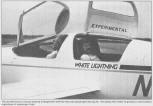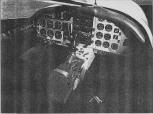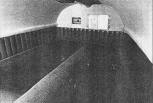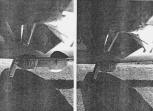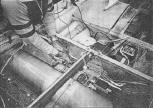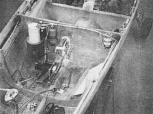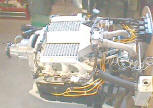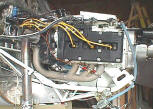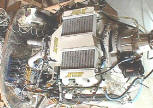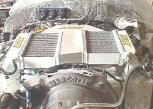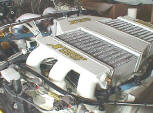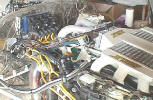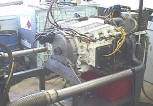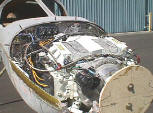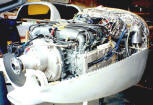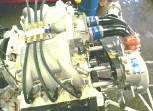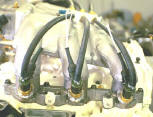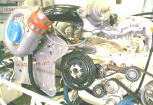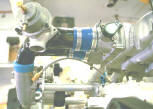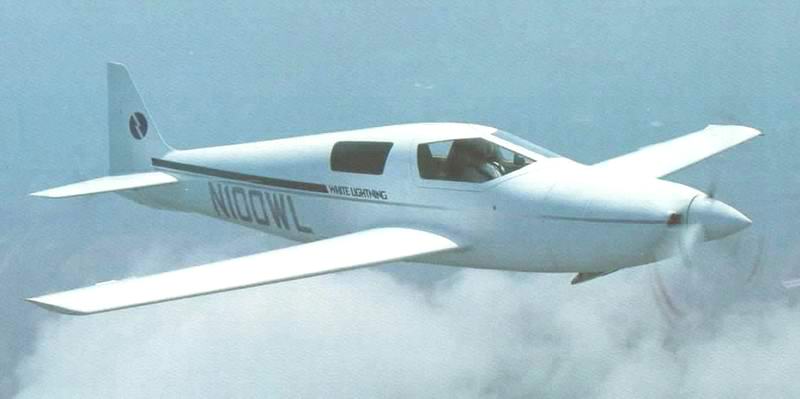
|
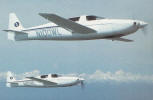  
White Lightning Flying : 10 Seats: 4 Top Speed :280 mph Cruise : 265 mph Stall : 67 mph Range : 1600 sm Climb : 1900 fpm TO Run : 1300 ft Landing : 1300 ft Ceiling :20000 ft Engine: 210HP Continental Empty :1400 lb Gross :2400 lb Wing Span : 27.7 ft Wing Area : 89.2 sqft Fuel : 70 gal Gear : TRI retract Status : kit Another retrofit EG33 Powered White LightningThis aircraft is owned by Greig and Leigh Huggins in Salt Lake City, Utah. The engine was built by Bud Clarke of Air Ryder in Montana. It is fitted with twin turbos, Marcotte redrive and an SDS EM-2 6F engine management system. More details will be posted as they become available. This should move! 05/15/01 Revised setup is now running in the airframe. |
|
The Nick Jones White Lightning Holder of Three World Speed Records |
|
|
When he hung up his helmet in 1976, ending ten years of hard charging Formula One racing, Nick Jones still had that spark of competitiveness burning in his soul. He still loved the chase and he still ached to win but he had come to a point in his life where trophies, token prize money and public acclaim were no longer enough. Somehow, he reasoned, there had to be greater rewards for all the resources, effort and daring that went into conventional air racing… rewards not only for participants, but also for all of aviation. It was that line of thought that led Nick to come to Oshkosh in 1978 with a concept for a new kind of air race, a concept that he says today, puts the emphasis on the cleverness of the airframe designer rather than on the amount of money spent on an engine.’ His race, originally named the Lowers, Baker, Falck 500 in memory of three fallen friends with whom he had raced, was technically an efficiency race in that fuel burn was limited. Efficiency races were not new, of course, there had been scores of those over the years, but Nick’s had its own special twist. His formula for determining scores rewarded speed so generously and penalized fuel consumption so severely that only the more efficient homebuilt designs had a chance to win, Indeed, to this day, no factory built airplane has been able to run the race and avoid disqualification for being too slow and/or too thirsty for 500 miles, including Piper’s highly regarded Malibu. So uncompromising were the rules that for the first three years the events were won by Formula One racers, first Steve Whitman and then Jerry Coughlin taking home most of the bacon. Nick took a lot of heat for this, but stood his ground (he’s never backed away from anything!). In so many words, he told his critics: “Don’t bellyache to me, go home and design something that will beat the racers. That’s what this is all about — to develop new airplanes that are a quantum leap ahead of what is out there today. This is not just a sporting event it’s a crucible for tomorrow’s airplanes.” He never had to tell A.J. Smith that. The former world and many times U. S. soaring champion had taken one look at the LBF rules and had headed for the drafting board. He showed up at Oshkosh in 1981 with his fabulous AJ-2 and proceeded to utterly destroy his competition . . . a feat he has repeated in every subsequent year. Since the AJ-2 has been the only aircraft designed specifically to win the LBF 500, Smith’s total domination of the race has, in one sense, been a resounding vindication for Nick’s basic premise — that quantum leaps in aircraft efficiency can be made. Initially, Nick was elated with A.J.’s success because he assumed others would be challenged to try to beat him. It didn’t happen, however— at least not fast enough for him. After a few years of growing frustration, Nick did the only thing his action oriented nature could countenance — he decided if no one else was willing to go after A. J., he’d do it himself. Nick had altered his rules a little over the years, making allowances for the extra flatplate area of side-by-side airplanes (as opposed to tandem jobs like the AJ-2, the Rutan canards, etc.). His goal had always been not only for his race to result in the development of new, significantly more efficient aircraft, but also for those aircraft to be made available to the public in the form of plans and kits. He knew that most pilots prefer a side-by-side configuration —so, he began bringing together a lot of ideas on what he thought the ideal two-place, side-by-side, high performance personal airplane should be. Early in the process, he brought a partner into the fold. Ray Ward, a fellow South Carolinian and an experienced builder with two Glasairs, two Pitts Specials, a Miniplane and several other projects to his credit, came aboard bringing with him the construction expertise that Nick amiably concedes is not his strong suit. Before any foam was butchered, however, a number of things happened to change the direction of Nick’s thinking. First, before he committed any resources to the project, he decided that it would be prudent to check out the competition. Consequently, he launched on a tour of the West Coast that included stops at Quickie Aircraft in Mojave and Stoddard-Hamilton in the Seattle area. He flew the 0-200 and both the fixed and retractable gear Glasair. . . and came away very favorably impressed with all three. Then along came Ed Swearingen’s new SX300 . . . which blew all of his ideas right out of the window! Since flying that airplane, Nick has been quite vocal in proclaiming to one and all that, in his opinion, “the SX300 is the finest reciprocating engine airplane in the world.” Finally, Nick sat down with Ray and said, “Those fellows have done such a good job, along with Rutan and his canards, that they have the 2-place market very adequately covered. What we’ve got to do is find ourselves a niche in the market that has not yet seen so much development . . . and the 4-place airplane looks to me like the way to go.” That was the moment of conception for the White Lightning. In overall concept, what evolved in Nick’s mind and, ultimately, on his drawing board was a 4-place, all-composite airplane that, while incorporating no new aerodynamic or mechanical features, combined known elements in ways that would result in an airplane that was faster and more fuel efficient for its power than any factory aircraft flying today. This, of course, involved compromises . . . compromises that in almost every instance where a decision had to be made were biased toward top end performance. As you can see in the accompanying photographs, the White Lightning is a conventional low wing, tail-in-the-rear, tractor airplane. It differs from the run of the mill factory 4-placers in that it has a much longer fuselage. This was the result of strict adherence to the rules of convergence on loft lines for bodies that are intended to move rapidly through the air. When a drawing curve was laid down on the paper and the pencil began scribing a line back from the spinner, it was never allowed to pinch in at an angle that might result in flow separation. The ultimate length of the fuselage was simply a function of how far back it took these shallow curves to finally converge. The only protuberance allowed was the windshield, and it was dramatically sloped backward. This compromised fuselage length has its payback — the long moment arm permits smaller, less draggy tail surfaces. Inside, the seating is arranged to keep the crew weight as close to the C.G. as possible, which is accomplished by facing the rear seats aft. The wing is short in length, high in aspect ratio, too thin to accommodate a retracted landing gear and fitted with big Fowler flaps. The landing gear, obviously borrowing heavily from the SX300, folds up into the fuselage. The main gear wheels nest just below the semi-reclining rear seat passenger’s knees, a space that could not be used for anything else. Powered with a normally aspirated, Six cylinder Continental 10-360 (210 hp), the White Lightning has a projected 75% cruise speed of 260 mph at 8,500 feet, a gross weight rate of climb of 1,500 fpm and a range of 1,500 miles at 75% power. The span is 27 ft. 8 in., the length is 23 ft. 4 in. and the empty weight is 1,350 pounds. Gross is 2,400 pounds. Standard fuel capacity is 70 gallons. That is the White Lightning in a nutshell. For more detail, let’s hear from Nick, himself. Sport Aviation — What was your design philosophy going into this project? Nick — My design philosophy was to create an airplane that was as aerodynamically clean as I could possibly make it. Everything went forward from that. When I came up with a preliminary design, I started looking at some pretty good performance numbers and realized that I had to get the wing area down. For an airplane that’s going to cruise at 250 to 260, a 20-pound wing loading is just not desirable. My Cessna 210 has a loading of about 21 pounds and at 170 mph in rough air it just beats you to death. Ed Swearingen, as you know, is the great guru of high wing loading, so I conversed with him at considerable length and ended up with a smaller wing — 89 sq. ft. — and a wing loading of 26.96 pounds per square toot. I’m not using one of the new very high lift airfoils. I’m using the old NACA 662 215 airfoil that looked like it would just about give me a legal single engine stall speed of 61 knots (for certificated airplanes) — if i did a really good job with my Fowler flaps. The same airfoil is used at the root and the tip, with zero angle of incidence at the root and two degrees negative at the tip. The taper ratio (thickness) is 2 and the aspect ratio (planform) is just under 9 to 1. A number of people helped me during the design phase, notably Ed Swearingen and Len Niemi. Ed let me bend his ear on numerous occasions and also allowed me to study his landing gear and “steal” the actuating mechanism. In detail my gear is different from his, except for the angle it uses to get up into the fuselage, but in general, it is the same concept. I really would not have been able to do mine if I hadn’t looked at his for a long time. There was no hands-on design help from Ed, but he certainly helped me with a lot of advice. On the other hand, Len Niemi of Greenville, SC, who designed the Sisu sailplane, his Sprinter and was involved with the design of the AJ-2 and other airplanes, was an active participant in the design of the White Lightning. Len did all the performance analyses and checked my structural analysis by different methods. He has been very, very helpful on the whole thing, including coming down to Sheldon (near Beaufort, SC) to help us build the molds. Sport Aviation—You told me earlier that this first airplane was built in production molds Nick — Yes, that’s arrogant . . . but building molds is such a terrible job that after getting into them, I decided I didn’t want to do that again, so we built production molds right from the start. A lot of people helped — Len, Eddie Clark who did so much work on the AJ-2 and quite a number of others. Some of those people had built molds for Lockheed-Georgia and they say ours compare favorably with Lockheed’s. They are high temperature epoxy molds and could be used for heat curing if we wanted to go that way. We are using a room temperature cure, however. I do plan to make a new set of wing molds. The ones we have were designed to get this plane (the prototype) in the air — they are not production molds. Sport Aviation — What materials are you using to make your molded parts? Nick — We are using a non-woven glass that is laid out at 45 degrees each way for the wings and the fuselage. We use Divinycell (PVC) foam cores in the upper and lower wing skins, but there is no foam in the fuselage. We use a lot of bulkheads, stringers and stiffeners, so we don’t need the foam. We used an epoxy resin on the prototype, but we are looking at several systems for production of our molded parts. We used a filled epoxy on the first airplane —filled with titanium dioxide and other fillers. We had to because our fuselage halves are so deep (20 inches) that if you use thin epoxy, you will get starvation at the top of the mold. We are bagging everything, except for the ribs and bulkheads that require greater pressure. We use hard rubber to put direct pressure on these parts. Sport Aviation — Nick, what was the time table on this . . . and where was the tooling actually built? Nick — The first line went on the first sheet of paper in June of 1984. We began making the fuselage plug that October and we got everyone together to start making the molds in January. We began making airworthy parts in the summer of 1985 and I flew the airplane for the first time on March 9, 1986. Some of the early work was done at my place but most of it was done at Ray Ward’s. We live across Huspa Creek (near Beaufort, SC) from each other, which is 12 or 14 miles by road, but just four or five minutes away in my Cub. We both have strips on our property, so we commuted by Cub and Luscombe to each other’s house during the construction. Sport Aviation — Who were some of the other people involved? Nick — Neil Brackett, who is a machinist, built the landing gear, the flap and control system parts — most of the metal parts .— and Ken Sparks, my old racing crew chief, made the engine baffling. Subsequently, we have been joined by Pete Wickwire, a retired Marine colonel, who is our business manager and, I’ve found, an excellent draftsman, and Ossie Fischer, who is our fiberglass expert. Ossie flew about 6,000 combat hours with the Luftwaffe in World War II and had 17 victories. He flew the 109, 190 and the Me. 262. He says it wasn’t a total loss for our side — because he was shot down three times himself! In the early going, Neil set Ray and myself free to build, design detail parts, systems, etc. He could make anything we could draw. I couldn’t have done this airplane without them — all of us contributed to the airplane you see here on the line at Sun ‘n Fun. Sport Aviation — Now, this airplane goes together differently than do most molded composite kits, doesn’t it? Nick—Yes, it has a “top and bottom” fuselage rather than the usual “left/right” halves. The bottom half of the fuselage is like a boat. It has a built up keel running down the bottom that carries all the principal loads — engine, landing gear and wing. It will be shipped to the customer with the keel, bulkheads, landing gearboxes and the main spar carry through installed to insure proper alignment. The tubular spar carry-through has a 5 degree bend in it to give each wing 2-1/2 degrees of dihedral. The landing gear, which will be manufactured by Airight, Inc. of Wichita, will come ready to bolt into the pre-drilled holes in the landing gear support boxes. Within 3 hours after unpacking his kit, the builder can have the lower half of the fuselage sitting on the gear. The advantage is that all the work of installing the engine, control system, instruments, etc. can be done with the boat-like bottom half of the fuselage standing on its gear at a Convenient working height. The top half of the fuselage, with the built-in canopy, is essentially a shell that fits atop the otherwise complete fuselage. Incidentally, the 3 gull wing-type canopies, the landing gear doors and the various inspection doors are made in separate tooling. They are then placed in the big molds and the fuselage shells are cast down upon them. This insures a perfect fit — and the builder does not have to cut holes in his fuselage. The vertical fin is not a part of the fuselage shell. It is separate — in two halves, one of which will be shipped to the builder with the spars and ribs bonded in. The horizontal stabilizer has a top and bottom skin, with the spars and ribs bonded to the top skin. The rudder and elevator are simple units with end ribs and top and bottom/left and right skins the builder will bond together. The rudder is derived from Steve Wittman’s Tailwind. Steve told me a long time ago that, in his experience, having the rudder not extend to the top of the fin makes it less susceptible to flutter. I’ve talked to some flutter experts and they agree. Also, the nearer the aerodynamic center of the rudder is located to the torsional axis of your fuselage, the less it tends to twist it. Sport Aviation — Detail the wing and its associated components. Nick — The wing has three spars: a tapered carbon fiber tubular main spar at 40% of chord; and two conventional shear web and cap type spars, the front one at 10% and the rear one at 72% of chord. The tubular main spar, which is cast on a mandrel by Composite Products of San Diego, plugs into the spar carry through in the fuselage and the front and rear spars attach to fuselage fittings with single bolts. The wing has two degrees of twist (washout) built into it, so in order to be absolutely sure it comes out that way, the lower skin of the wing will be shipped, in a support cradle, with the spars and ribs bonded in and with the top skin clecoed in place (in pilot holes). The tracks for the Fowler flaps will also come bonded in place. There are just two for each wing panel, located at the outboard ends of the flaps, so they have to be in proper alignment. There is a factory molded leading edge cap to fair the upper and lower wing skins. The White Lightning has a total fuel capacity of 70 gallons the tubular spar holds 28 gallons and the rest is in the void between the front and main spar. Each fuel area is piped separately into a fuselage sump which, in turn, feeds the engine. Sport Aviation — What kind of control actuation mechanism are you using? Nick — The rudder is actuated with cables and the rest, including the flaps, are actuated with pushrods. Sport Aviation — In such a fast airplane, obviously the control surfaces are balanced Nick — The ailerons and elevator are 100% dynamically balanced. The aileron counterweight runs the full length of the leading edge of the aileron. We are retaining the services of Mr. Leon Tolv, one of the world’s leading experts on flutter, to do a flutter analysis of the White Lightning shortly after we return home from Sun ‘n Fun. He will come to our place with his equipment and shake the airplane. We have already done a static torsion test on the wing to comply with the government’s paper No. 45 on simplified flutter prevention criteria. It showed the wing is very stiff… in fact, based on that criterion only, it is good for something like 800 mph! Obviously, however, there are more things that have to be taken into consideration than that single test. The airplane has a design dive speed (not the redline) of 375 mph. The normal practice is to back off from your design dive speed by 10% to get your redline. I think for a kit-built airplane, however, that 20% is more in order, We think a 300 mph redline is needed for an airplane that cruises at 260 mph, so we have designed to 375. As soon as the flutter analysis has been done, I will fly the airplane to Mississippi State University’s Raspet Flight Test Center where it will undergo a full certification type flight test program. That will include spin testing and dives to our design dive speed of 375... I'll be doing the flying and I’m not looking forward to that after the experience I once had in a Formula One racer. I had a wing flutter in a dive test and literally explode. When I got out of the remaining fuselage, it was going about 500 mph! I don’t want to do that again! So far, we haven’t found anything we dislike on the White Lightning and don’t expect to during the flight tests. However, anything that doesn’t meet Part 23 for a certified airplane will be so noted to builders so they can avoid that area of the flight envelope. Sport Aviation — Now let’s talk about the engine and propeller. Nick — We’re using a six cylinder Continental 10-360 that’s rated at 210 hp. The engine is plentiful — it’s used in the Cessna Skymaster, the Mooney and a number of Piper singles and twins. It has the advantage of being about 3 inches narrower than the 0-360 Lycoming and having had several propeller failures over the years, I simply prefer a lot of small power impulses to a few large ones. The propeller on the prototype is a 3-blade Hoffmann that is approved for use on a 300 hp Lycoming, so it’s a little bit heavy. Hoffmann was the only company that would design a blade for the speed we are going. It incorporates a super critical airfoil and has a rather odd blade plantorm. The blades are composite, which probably contributes to the quietness. I have really been impressed with the quietness of the airplane —both inside it and out. A part of the quietness is the accident of my hitting the proper exhaust pipe length. They are simply 3 into 1 pipes exhausting into tunnels on the bottom of the fuselage, but they are really quiet. I raced Formula Ones for 11 years and if you don’t know a little about cooling drag, you will never make it into the final championship heats. I thought I knew a lot about it until I talked to Ed Swearingen — and really learned something. Using all I knew and what I learned from Ed, I came up with a cowling/interior baffling design that allows us to cool the engine without having to use cowl flaps. In fact, I’m running a little too cool on the 4 rear cylinders. We will tweak the baffles a little to equalize the operating temperature of all six cylinders and may cut down on the area of the inlets. The outlet area is already so small, I don’t know if it can be reduced. We are very pleasantly surprised with our cooling. I’m very proud of the baffling Ken Sparks built — we won’t be ashamed to show it at any fly-in. Sport Aviation — I know that your flight-testing to date has been limited pending the flutter analysis, but what have you learned about the airplane so far? Nick — Well, we’ve been pleasantly surprised at how trouble tree it has been. We had to do a little work on our fuel injection system, initially, but since we got it straightened out, we have been pleased with the airplane. It doesn’t have any bad stall characteristics and the stall speed is a little lower than we expected. Our Fowler flaps are really working — they lower the stall speed 20 mph! The airplane stalls at 90 mph indicated at gross with the flaps up and at 70 with them down. By comparison, the Fowler flaps on my 210 lower the stall speed about 9 mph. Perhaps one reason is that our flap installation is much cleaner. Each flap on the 210 has 3 tracks, 2 tips and 2 actuators — or a total of 7 points at which the airflow is disturbed. On the White Lightning, each flap has 2 tracks, 2 tips and 2 actuators — all located at the ends of the flap, so there are only 2 points at which the airflow is torn up. Further, the outboard ends of the flaps have endplates that streamline the flap track there, as well as serving as a flow fence. Sport Aviation — What percent of chord are the flaps? Nick — The nose of the flap is at 72.6% of chord, so they are 27.4%. They go down to 35 degrees and, of course, go back.
Sport Aviation — What rpm/mp speed combinations have you seen within your self-imposed top end limitation? Nick — Flying to Lakeland for Sun ‘n Fun in formation with the 210, the Cessna with 2 aboard, was running at 2500 rpm and 23 inches, which was full throttle at our cruising altitude, while I had to throttle the White Lightning back to 2250 rpm and between 13 and 14 inches to remain alongside. I was alone in the airplane because we were on a ferry permit. With just under 10 hours, the FAA was good enough to allow us to fly it to and from Florida to show the airplane — but we were not authorized to do any local flying. (Editor’s Note — In subsequent phone conversations with Nick, Sport Aviation learned the aircraft’s 40 hours of FAA test time were flown off within about three weeks after Sun ‘n Fun.) We are very confident that we will meet our performance projections. It seems to be running right along the low drag curve that Len Niemi came up with. And, yet, we have an airplane that is easy to fly. It is a high performance airplane and must be respected as such, but there are no special handling techniques required. I was concerned about pitch down when the gear is lowered, so we rigged the gear doors to close after the gear is down to minimize drag . . . and it works. Pitch down is less than on my Cessna 210. Control pressures are fairly light and the side controller (stick) has a good feel. The seats are comfortable, the cabin is 42 inches wide and the visibility is great. We are really happy with this airplane. This informational page is the work of Luther Moon a once proud kit owner. Should someone feel the need to update, add more information... or to just leave a comment... please contact me with particulars, Thanks... |

